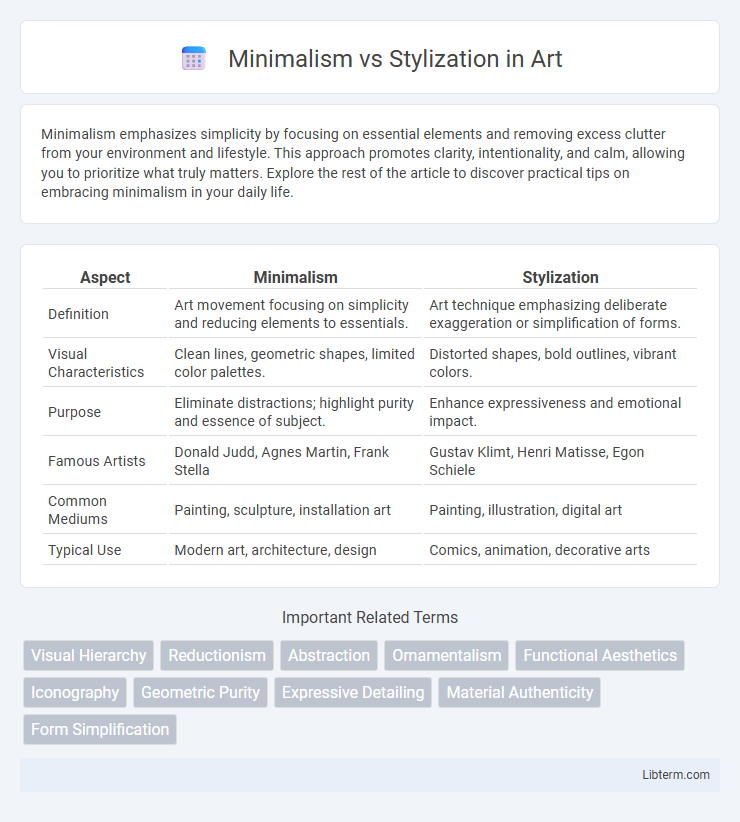Minimalism emphasizes simplicity by focusing on essential elements and removing excess clutter from your environment and lifestyle. This approach promotes clarity, intentionality, and calm, allowing you to prioritize what truly matters. Explore the rest of the article to discover practical tips on embracing minimalism in your daily life.
Table of Comparison
| Aspect | Minimalism | Stylization |
|---|---|---|
| Definition | Art movement focusing on simplicity and reducing elements to essentials. | Art technique emphasizing deliberate exaggeration or simplification of forms. |
| Visual Characteristics | Clean lines, geometric shapes, limited color palettes. | Distorted shapes, bold outlines, vibrant colors. |
| Purpose | Eliminate distractions; highlight purity and essence of subject. | Enhance expressiveness and emotional impact. |
| Famous Artists | Donald Judd, Agnes Martin, Frank Stella | Gustav Klimt, Henri Matisse, Egon Schiele |
| Common Mediums | Painting, sculpture, installation art | Painting, illustration, digital art |
| Typical Use | Modern art, architecture, design | Comics, animation, decorative arts |
Understanding Minimalism: Core Principles
Minimalism centers on simplicity, using clean lines, limited color palettes, and removing unnecessary elements to create clarity and focus. It emphasizes functionality and the essence of design, eliminating distractions to enhance user experience or visual impact. Key principles include intentional use of space, purposeful typography, and restraint in decoration, allowing the core message or form to stand out.
Defining Stylization in Design and Art
Stylization in design and art emphasizes the deliberate alteration or exaggeration of natural forms to create a distinctive, often symbolic appearance. Unlike minimalism, which focuses on simplicity and essential elements, stylization incorporates decorative details, patterns, and abstract shapes to convey mood or cultural context. This approach enhances visual storytelling by prioritizing expressive form over realistic representation.
Historical Context: Origins of Both Movements
Minimalism emerged in the 1960s as a reaction against the complexity of Abstract Expressionism, emphasizing simplicity, geometric forms, and monochromatic palettes, with pioneers such as Donald Judd and Agnes Martin shaping its foundation. Stylization, rooted in ancient art practices and significantly developed during the Art Nouveau and Art Deco movements, prioritizes decorative, exaggerated, and abstracted forms to convey aesthetic or symbolic meanings. Both movements reflect distinct historical responses to cultural and artistic shifts: Minimalism towards reduction and purity, Stylization towards ornamental expression and narrative.
Visual Impact: Simplicity vs. Expression
Minimalism emphasizes visual impact through simplicity, using clean lines and limited color palettes to create clarity and focus. Stylization enhances visual expression by incorporating exaggerated features, intricate details, and bold colors that convey personality and emotion. The choice between minimalism and stylization depends on whether the design prioritizes straightforward visual clarity or dynamic, expressive storytelling.
Functionality and User Experience
Minimalism prioritizes simplicity by eliminating unnecessary elements, enhancing functionality through clear, intuitive designs that reduce user cognitive load. Stylization emphasizes unique visual elements and aesthetics, potentially enriching user experience by creating engaging interfaces but risking distractions or usability challenges. Balancing minimalism's functional clarity with stylization's expressive appeal ensures effective user interactions and a visually pleasing experience.
Emotional Resonance: Subtlety vs. Statement
Minimalism leverages subtle design elements and restrained color palettes to evoke calmness and introspection, fostering deep emotional resonance through understated elegance. Stylization employs bold shapes, vivid colors, and exaggerated forms to create immediate visual impact and strong emotional statements that command attention. The contrast between minimalism's nuanced subtlety and stylization's expressive intensity shapes the viewer's emotional experience and interpretative response.
Applications in Modern Media and Design
Minimalism emphasizes simplicity and clean lines, promoting functionality and a clutter-free visual experience in modern media and design. Stylization focuses on artistic expression, using exaggerated forms and unique aesthetics to convey specific emotions or brand identity. Both approaches shape user engagement and brand perception through distinct visual strategies in digital interfaces, advertising, and graphic design.
Advantages and Drawbacks of Minimalism
Minimalism in design emphasizes simplicity, clarity, and functionality, offering advantages such as reduced visual clutter, enhanced user focus, and faster loading times in digital platforms. Its drawbacks include potential lack of visual interest and emotional engagement, which can lead to a perception of coldness or underwhelming aesthetics. Businesses leveraging minimalist approaches must balance clean design with meaningful content to maintain user attention and brand identity.
Pros and Cons of Stylization
Stylization offers creative freedom by enhancing visual interest and conveying specific moods or themes, making designs more engaging and memorable. However, it can sometimes reduce clarity or usability, especially if exaggerated elements distract from the core message. Balancing stylization with functional design principles ensures aesthetics do not compromise user experience or communication effectiveness.
Choosing Between Minimalism and Stylization
Choosing between minimalism and stylization depends on the desired visual impact and brand identity. Minimalism emphasizes simplicity, clean lines, and functionality, enhancing user experience through clarity and ease of use. Stylization allows for more creativity and personality, incorporating unique features and artistic flair to capture attention and convey a distinct message.
Minimalism Infographic

 libterm.com
libterm.com